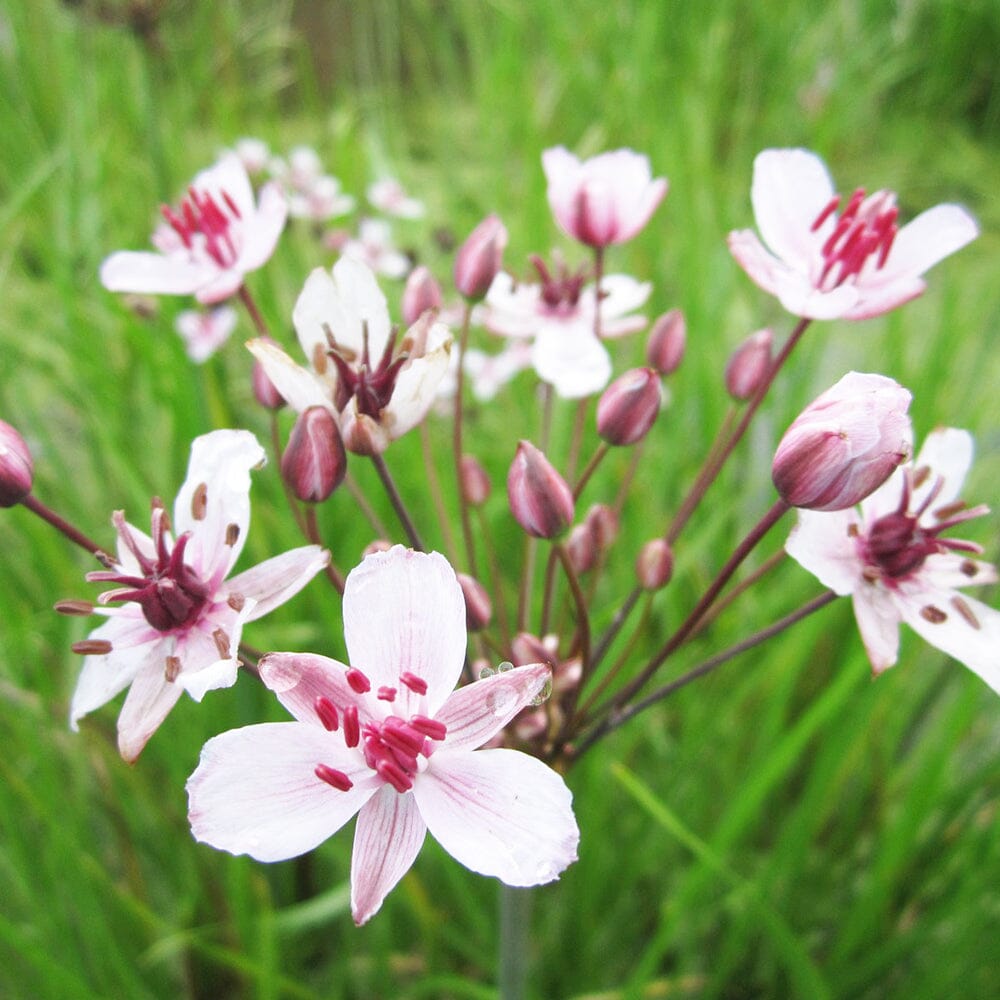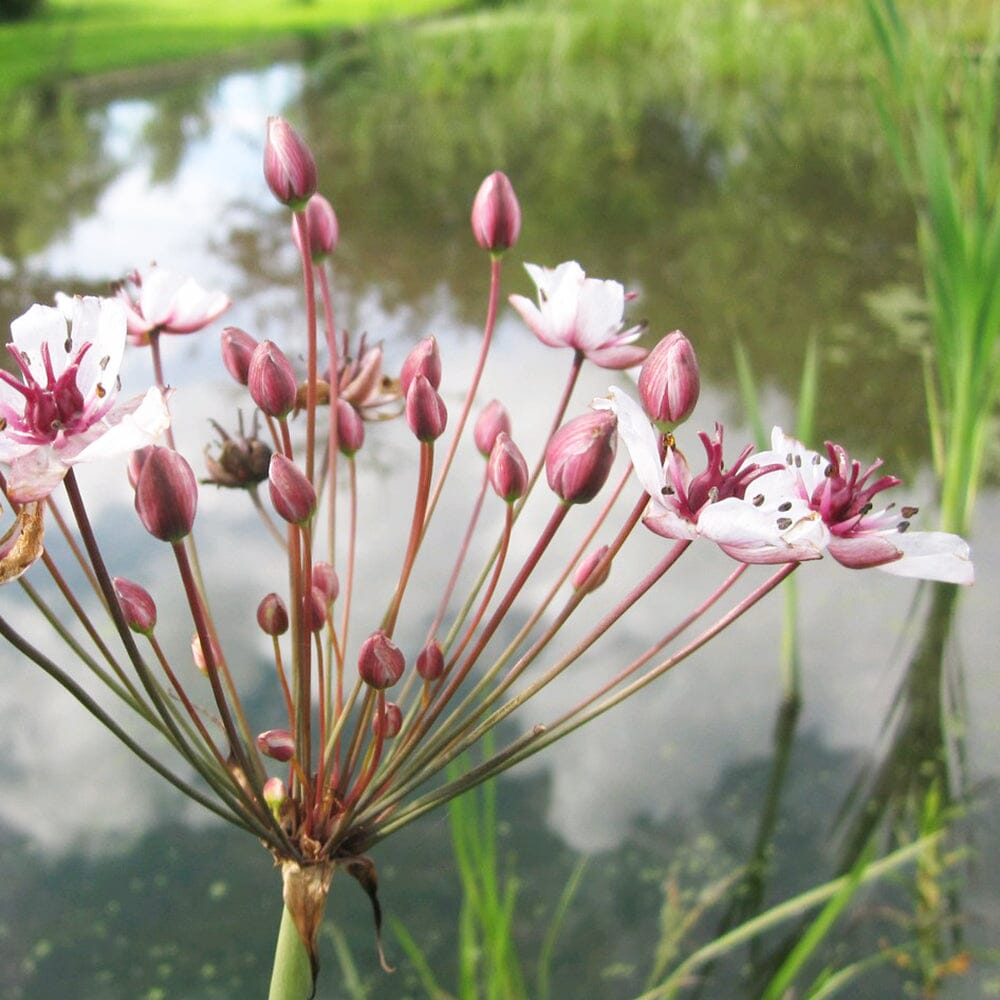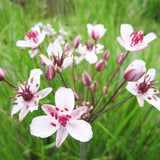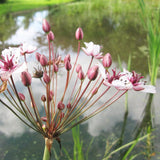Butomus Umbellatus Aquatic Pond Plant - Flowering Rush
Butomus umbellatus, commonly known as Flowering Rush, is a perennial aquatic plant that is native to wetland areas of Europe, Asia, and North Africa. It is valued for its attractive pink flowers and sword-like foliage. Here's a detailed description and care guide for Butomus umbellatus:
Description:
Butomus umbellatus is a robust plant that typically grows to a height of 2-4 feet (60-120 cm) with a spread of 1-2 feet (30-60 cm). It features tall, erect stems with linear, sword-shaped leaves that emerge from the base of the plant. The leaves have a blue-green color and are arranged in a spiral pattern. In summer, Butomus umbellatus produces clusters of pink flowers at the tips of the stems. The flowers have six petals and are arranged in an umbel-like inflorescence, hence the name "umbellatus." After flowering, the plant develops small, elongated fruits that contain the seeds.
Care Guide:
Lighting: Butomus umbellatus thrives in full sun to partial shade. It prefers at least 4-6 hours of direct sunlight each day for optimal growth and flowering. However, it can tolerate some shade, particularly in hotter regions or during the hottest part of the day.
Water: Butomus umbellatus is an aquatic plant and requires consistently moist soil or shallow water conditions. It naturally grows in marshes, wetlands, or along the edges of ponds, lakes, or slow-moving streams. Ensure that the water level is suitable for the plant's growth, with the base of the plant submerged in water or planted in wet soil.
Soil: Butomus umbellatus prefers fertile, loamy soil that is rich in organic matter. It can tolerate a range of soil types, including sandy or clay soils, as long as they retain moisture. In a water garden or pond setting, ensure that the plant is anchored in a suitable aquatic planting medium or in the muddy substrate at the bottom.
Temperature: Butomus umbellatus is hardy in USDA hardiness zones 4-9. It can tolerate a range of temperatures but generally prefers mild to cool climates. It may struggle in regions with extremely hot or dry summers, so providing some shade or protection during the hottest periods can help maintain its vigor.
Nutrient Requirements: Butomus umbellatus benefits from regular fertilization to support healthy growth and flowering. Use a balanced, slow-release aquatic plant fertilizer or a fertilizer specifically formulated for water plants. Follow the manufacturer's instructions for dosage and frequency, as excessive fertilization can contribute to algae overgrowth.
Maintenance: Regular maintenance helps keep Butomus umbellatus healthy and attractive. Remove any dead or faded flowers and trim back any yellowing or damaged leaves. After the flowering season, prune back the stems to maintain the plant's shape and prevent excessive seed production.
Propagation: Butomus umbellatus can be propagated through division or by collecting and sowing its seeds. Division is best done in early spring or fall when the plant is actively growing. Carefully separate the clumps and replant them in suitable soil or aquatic medium. Seeds can be collected from mature flower heads and sown in containers or directly in the water.
Pests and Diseases: Butomus umbellatus is generally resistant to pests and diseases. However, it may occasionally attract pests like aphids or be prone to fungal diseases if the conditions are overly moist. Monitor the plant regularly for signs of pests or diseases and take appropriate measures if necessary.
By following these care guidelines, you can enjoy the attractive pink flowers and foliage of Butomus umbellatus in your water garden or pond. Adjust the care routine based on your specific growing conditions and monitor the plant for any signs of stress, pests, or diseases. With proper care, Butomus umbellatus can provide a beautiful and natural addition to aquatic landscapes while contributing to the health of the ecosystem.
Selection:
Research different species of marginal pond plants to find ones that suit your pond's conditions and your aesthetic preferences. Consider factors such as height, flower colour, foliage texture, and seasonal interest when selecting plants.
Placement:
Observe the natural conditions of your pond, such as sun exposure, soil type, and water movement, and choose plants that are adapted to those conditions. Create different planting zones around the pond, with plants that prefer wet soil closer to the water's edge and those that tolerate drier soil further away.
Sunlight:
Marginal plants typically thrive in full sun to partial shade. Some species can tolerate more shade, but for optimal growth and flowering, provide them with at least 6 hours of direct sunlight per day.
Water Depth:
Determine the water depth requirements of the marginal plants you choose. Some plants prefer water up to 6 inches deep, while others can tolerate water up to 12 inches or more. Ensure that the water level remains consistent within the preferred range for the chosen plants.
Soil:
Marginal plants prefer a rich, loamy soil that retains moisture but is not waterlogged. Amend the soil with organic matter, such as compost or well-rotted manure, to improve its fertility and drainage. Avoid using heavy clay soil, as it can become compacted and restrict root growth.
Planting:
Dig a hole slightly larger than the root ball of the plant and loosen the soil at the bottom. Place the plant in the hole, ensuring that the crown is level with or slightly above the soil surface. Backfill the hole with soil and gently firm it around the plant to eliminate air pockets. Water thoroughly after planting to settle the soil and provide initial hydration.
Mulching:
Apply a layer of organic mulch around the base of the plants to suppress weeds, conserve moisture, and regulate soil temperature.Use materials like straw, shredded bark, or compost, and maintain a depth of 2-3 inches.
Watering:
Marginal plants prefer consistently moist soil but should not be waterlogged. Monitor the moisture level regularly and water as needed to keep the soil evenly moist. During hot and dry periods, provide supplemental watering to prevent the soil from drying out.
Fertilization:
Marginal plants generally do not require heavy fertilization if the soil is nutrient-rich. However, if growth appears weak or leaves show signs of nutrient deficiencies, apply a balanced slow-release fertilizer according to the manufacturer's instructions.
Maintenance:
Remove any yellowing or dead leaves to maintain plant health and appearance. Divide overcrowded plants every few years to prevent competition for resources and promote vigorous growth. Prune back excessive growth to maintain a tidy appearance and to prevent plants from encroaching on other plants or the pond itself.
Winter Care:
Hardy marginal plants can withstand winter temperatures and require minimal care. Cut back dead foliage in late fall or early spring to tidy up the planting area. In colder regions, consider protecting tender plants with a layer of mulch or covering them with burlap during winter to prevent frost damage.
Monitoring and Troubleshooting:
Regularly inspect plants for signs of pests, diseases, or nutrient deficiencies. Address any issues promptly with appropriate treatments, such as organic insecticides, fungicides, or nutrient amendments. By following these detailed tips and providing proper care, you can create a beautiful and thriving planting zone around your pond, enhancing its visual appeal and supporting a diverse ecosystem.
































